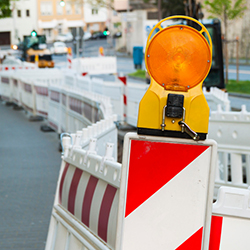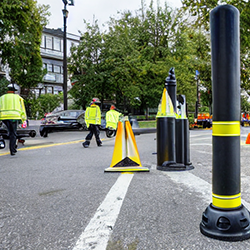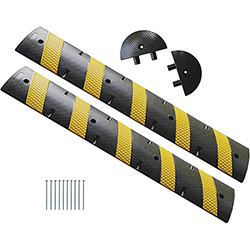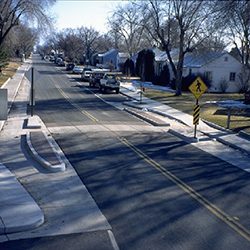Overview
Introduction to speed bumps
Speed bumps are an essential component of road safety measures, designed to slow down vehicles and ensure the safety of pedestrians and drivers alike. In this article, we will delve into the manufacturing process behind
high-quality speed bumps. The introduction to speed bumps is crucial in understanding their purpose and significance on the roads. One important aspect of speed bumps is the
cable cover, which plays a vital role in protecting underground cables and wires. The manufacturing process involves carefully selecting durable materials and employing precise techniques to create speed bumps that are long-lasting and effective. By exploring the manufacturing process, we can gain a deeper appreciation for the engineering and craftsmanship that goes into producing high-quality speed bumps.
Importance of high-quality speed bumps
High-quality speed bumps play a crucial role in ensuring road safety and preventing accidents. They are designed to slow down vehicles and enforce traffic regulations, especially in areas with high pedestrian activity or near schools and residential areas. The importance of high-quality speed bumps lies in their ability to effectively control vehicle speed,
reduce the risk of collisions, and protect pedestrians from potential harm. These speed bumps are specifically engineered to withstand heavy traffic and adverse weather conditions, ensuring their durability and longevity. By installing high-quality speed bumps, communities can effectively minimize the chances of accidents and
damage prevention, creating
safer roads for everyone.
Overview of the manufacturing process
The manufacturing process of high-quality speed bumps involves several steps. First,
rubber is selected as the primary material due to its durability and flexibility. The rubber is then mixed with various additives and chemicals to enhance its strength and resistance to wear and tear. Next,
the mixture is poured into molds and left to cure for a specific period of time. Once cured, the speed bumps are removed from the molds and undergo a quality control inspection to ensure they meet the required standards. Finally, the speed bumps are ready for installation, which involves proper placement and securing to ensure optimal functionality and safety.
Design and Material Selection
Factors to consider in speed bump design
When designing speed bumps, there are several factors that need to be considered. One of the most important factors is the height of the speed bump. The height should be sufficient to slow down vehicles without causing discomfort or damage. Another factor to consider is the width of the speed bump. It should be wide enough to span the entire width of the road, ensuring that vehicles cannot avoid it. Additionally, the
material used in the construction of the speed bump is crucial. It should be durable and able to withstand heavy traffic and varying weather conditions. Finally, the
placement of the speed bump is also important. It should be strategically placed in areas where speeding is a concern, such as near schools or residential areas.
Choosing the right materials
When it comes to choosing the right materials for manufacturing high-quality speed bumps, there are several factors to consider. One of the most important considerations is
durability. Speed bumps need to be able to withstand heavy traffic and constant exposure to the elements, so selecting materials that are strong and long-lasting is crucial. Another factor to keep in mind is visibility. Speed bumps should be easily visible to drivers, especially in low-light conditions, to ensure maximum safety. This means choosing materials that can be easily painted or have reflective properties. Additionally, the materials used should be
resistant to cracking and fading, as this can affect the effectiveness and appearance of the speed bumps over time. Overall, selecting the right materials is essential in creating high-quality speed bumps that are durable, visible, and long-lasting.
Impact of design on durability and effectiveness
The design of speed humps plays a crucial role in determining their durability and effectiveness. Speed humps are specifically engineered to slow down vehicles and improve road safety. The shape, size, and material used in the manufacturing process greatly impact the performance of speed humps.
High-quality speed humps are designed to withstand heavy traffic and harsh weather conditions, ensuring long-lasting effectiveness. Additionally, the design of speed humps also affects their visibility and impact on driver behavior. Speed humps with clear markings and appropriate height can effectively grab the attention of drivers and encourage them to reduce their speed. Therefore, it is essential to consider the design aspects when manufacturing high-quality speed humps.
Molding and Shaping
Injection molding process
The injection molding process is a key step in the manufacturing of high-quality speed bumps. This process involves injecting molten plastic into a mold cavity, allowing it to cool and solidify, and then removing the molded part from the mold. Injection molding is widely used in the production of speed bumps due to its ability to create complex shapes with
high precision and consistency. The process ensures that the speed bumps have a smooth and uniform surface, which is essential for their effective performance. Additionally, injection molding allows for the incorporation of features such as textured surfaces and reflective elements, enhancing the visibility and durability of the speed bumps. Overall, the injection molding process plays a crucial role in producing high-quality speed bumps that meet the stringent requirements of
road safety standards.
Shaping the speed bump profile
The shaping of the speed bump profile is a critical step in the manufacturing process. It determines the effectiveness and durability of the speed bump in controlling vehicle speed and ensuring safety. The profile of the speed bump is carefully designed to achieve optimal performance. The height, width, and slope of the bump are calculated to create the desired impact on vehicle speed while minimizing discomfort to drivers.
Speed bumps offer numerous benefits, including reducing vehicle speed in high-risk areas, improving pedestrian safety, and preventing accidents. By shaping the speed bump profile with precision, manufacturers can create high-quality speed bumps that effectively fulfill their intended purpose.
Ensuring consistent dimensions
In order to ensure consistent dimensions, the manufacturing process of high-quality speed bumps follows a strict set of guidelines. These guidelines include precise measurements and tolerances to guarantee that each speed bump produced meets the required specifications. Additionally,
advanced technologies such as computer-aided design (CAD) and computer numerical control (CNC) machines are utilized to achieve accuracy and precision during the manufacturing process. These technologies enable the creation of molds and the shaping of speed bump components with utmost precision. Furthermore,
thorough quality control checks are conducted at various stages of the manufacturing process to identify and rectify any deviations from the desired dimensions. By adhering to these meticulous procedures, manufacturers can guarantee that their high-quality speed bumps have consistent dimensions, ensuring optimal performance and safety on the roads.
Reinforcement and Strength
Adding reinforcement materials
In the manufacturing process of high-quality speed bumps, one crucial step is
adding reinforcement materials. These materials are essential for ensuring the durability and strength of the speed bumps. Reinforcement materials, such as steel rods or fiberglass, are strategically placed within the speed bump structure to enhance its ability to
withstand heavy traffic and harsh weather conditions. By adding these materials, the speed bumps become more resistant to wear and tear, reducing the need for frequent repairs or replacements. Additionally, the use of reinforcement materials also improves the overall performance and longevity of the speed bumps, making them a reliable solution for traffic calming measures.
Enhancing strength and durability
The manufacturing process behind high-quality speed bumps involves various techniques to enhance their strength and durability. One of the key factors in this process is the use of
high-quality materials, such as rubber compounds that are specifically formulated for durability and resistance to wear and tear. Another important aspect is the design of the speed bumps, which includes features like reinforced ribs and grooves that provide additional strength and stability. Additionally, advanced manufacturing methods, such as
compression molding and vulcanization, are used to ensure the speed bumps are solid and long-lasting. These techniques result in speed bumps that can withstand heavy traffic and harsh environmental conditions, making them ideal for use in various settings such as parking lots, residential areas, and industrial sites.
Testing for load-bearing capacity
The
testing phase for load-bearing capacity is a crucial step in the manufacturing process of high-quality speed bumps. It ensures that the speed bumps can withstand the weight of vehicles without getting damaged or deformed. During this phase, various tests are conducted to evaluate the
strength and durability of the speed bumps. These tests include applying different loads and measuring the deflection and deformation of the speed bumps. The results of these tests help determine the maximum weight the speed bumps can bear and ensure their effectiveness in controlling vehicle speed. The
long keyword is an essential factor in determining the load-bearing capacity of the speed bumps. By considering the long keyword, manufacturers can design and produce speed bumps that meet the required standards and specifications. The highlights of the testing phase include evaluating the performance of the speed bumps under different load conditions and ensuring their reliability and safety.
Surface Preparation and Finishing
Smoothing the surface
The manufacturing process of high-quality speed bumps involves several steps. One important step is smoothing the surface. This is done to ensure that the speed bump is safe and comfortable for vehicles to drive over. During this process, any rough or uneven areas on the surface of the speed bump are carefully smoothed out. This helps to
prevent any potential damage to vehicles and also provides a
smoother driving experience. Smoothing the surface also helps to improve the overall appearance of the speed bump, making it more visually appealing. By taking the time to properly smooth the surface, manufacturers can ensure that their speed bumps meet the highest standards of quality and performance.
Applying anti-slip coatings
Applying anti-slip coatings is an essential step in ensuring
pedestrian safety when it comes to speed bumps. These coatings provide traction and grip, preventing vehicles from skidding or sliding when driving over the speed bumps. By applying anti-slip coatings to speed bumps, the risk of accidents and injuries to pedestrians is significantly reduced. Pedestrians can confidently walk over these speed bumps without worrying about slipping or falling. The anti-slip coatings also enhance the visibility of the speed bumps, making them more noticeable to drivers and further increasing pedestrian safety. Overall, the application of anti-slip coatings plays a crucial role in creating high-quality speed bumps that prioritize pedestrian safety.
Reflective markings for visibility
Reflective markings are an essential feature of high-quality speed bumps. These markings enhance
visibility, especially during nighttime or low-light conditions. By using reflective materials, speed bumps become more noticeable to drivers, reducing the risk of accidents. In Jacksonville, where traffic safety is a top priority, the use of reflective markings on speed bumps is particularly important. These markings can be customized to include keywords like ‘Jacksonville’ as short highlights, which can be turned into hyperlink text, providing additional information about
traffic regulations and safety measures in the city.
Quality Control and Testing
Inspection of finished speed bumps
After the manufacturing process is complete, the speed bumps undergo a thorough inspection to ensure their quality and effectiveness. This inspection involves checking for any
defects or imperfections in the speed bumps, such as cracks or uneven surfaces. The inspectors also verify that the speed bumps meet the
required specifications and dimensions. Additionally, they test the durability and resilience of the speed bumps by subjecting them to simulated heavy traffic conditions. The goal of this inspection is to guarantee that the speed bumps will effectively slow down vehicles and enhance safety on the roads of Seattle.
Testing for compliance with standards
Testing for compliance with standards is a crucial step in the manufacturing process of high-quality speed bumps. To ensure that these traffic calming devices meet the necessary requirements,
rigorous testing procedures are implemented. These tests evaluate various aspects such as durability, impact resistance, and visibility. One of the key standards that speed bumps must adhere to is the ASTM International Standard Specification for Speed Bumps (ASTM D4123). This standard sets guidelines for the dimensions, materials, and performance of speed bumps. By conducting thorough testing, manufacturers can guarantee that their speed bumps are
safe, reliable, and effective in slowing down vehicles and improving road safety.
Ensuring consistent quality
Ensuring consistent quality in the manufacturing process is crucial for producing
high-quality speed bumps. To achieve this, several steps are taken to ensure that every speed bump meets the required standards. First, the raw materials used in the production are carefully selected and tested for their durability and strength. Only the highest quality materials are chosen to ensure the longevity of the speed bumps. Next, a precise and controlled manufacturing process is followed, where each speed bump is carefully molded and shaped to meet the desired specifications. This includes ensuring the correct dimensions, angles, and surface texture. Additionally, strict quality control measures are implemented at every stage of the manufacturing process to identify and rectify any defects or imperfections. This includes thorough inspections, testing, and quality assurance checks. By maintaining a rigorous quality control system, manufacturers can guarantee that each speed bump is of the highest standard and will effectively serve its purpose of enhancing road safety.
Conclusion
Summary of the manufacturing process
The manufacturing process of high-quality speed bumps involves several steps. First, a mixture of concrete is prepared, which includes aggregate, cement, and water. This mixture is then poured into molds of the desired shape and size. After the concrete has set and hardened, the speed bumps are removed from the molds and allowed to cure. Once the
curing process is complete, the speed bumps are inspected for any imperfections and undergo
quality control checks. Finally, the speed bumps are ready to be installed on roads and parking lots, providing a safe and effective means of traffic calming.
Importance of high-quality speed bumps
High-quality speed bumps play a crucial role in ensuring road safety and effective
traffic calming. Understanding traffic calming is key to implementing effective measures to control vehicle speed and improve
pedestrian safety. Speed bumps are designed to slow down vehicles and encourage drivers to be more cautious, especially in areas with high foot traffic or near schools and residential areas. By installing high-quality speed bumps, cities and communities can create a safer environment for pedestrians and reduce the risk of accidents and injuries. Moreover, these speed bumps can also help in reducing noise pollution and minimizing vehicle emissions, contributing to a more sustainable and livable urban environment.
Future advancements in speed bump technology
Future advancements in speed bump technology are expected to revolutionize the way we approach traffic calming measures. With the increasing emphasis on sustainability and eco-friendly solutions, researchers are exploring the use of recycled materials in the manufacturing of speed bumps. These eco-friendly speed bumps not only reduce waste but also provide a durable and long-lasting solution. Additionally, advancements in sensor technology are enabling the development of smart speed bumps that can detect approaching vehicles and adjust their height accordingly. This not only ensures a smoother ride for drivers but also enhances safety by preventing accidents caused by high-speed vehicles. Furthermore, the integration of solar panels into speed bumps is being explored as a way to generate
renewable energy and contribute to the overall
sustainability of transportation systems. With these future advancements, speed bumps will not only serve as traffic calming devices but also as innovative solutions that promote a greener and safer environment.






